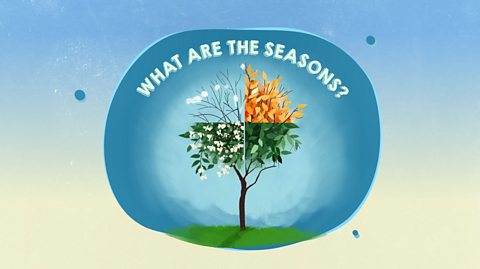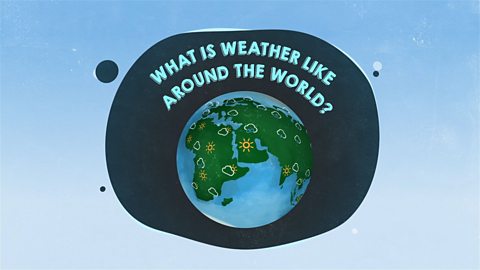This video explores the relationship of the Earth to the sun - the cause of our changing seasons.
What causes the seasons?
Maddie: These three are enjoying the season of winter! There are four seasons in every year.
Child: Spring, summerÔÇŽ
Child: Autumn and winter.
Maddie: They all look and feel quite different. Do you know what causes the seasons?
Child: Is it the sun?
Maddie: You're right, it does have a lot to do with the the sun. We live on the Earth. Earth is one of eight planets in a group called the solar system, but only Earth has living things on it. At the centre of the solar system is our sun. The sun is an enormous ball of energy that lights and warms our planet.
Throughout the year, all the planets, including the Earth move around the sun in what is called an orbit. It takes 365 days for Earth to orbit the sun. That's one whole year! As the Earth goes around the sun, it's also spinning around like this. The Earth isn't completely upright, it spins on a tilt which means the sun's rays aren't always hitting the same spot. So at different times of the year, a different part of the planet is tilted towards the sun.
Here's where the UK is on the planet. So when our part of the Earth is tilted towards the sun our weather is hotter and with more hours of daylight. This is our summer. But when our part of the Earth is tilted away from the sun, fewer of the sun's rays are reaching us. It's colder and darker. This is our winter.
Child: Are the seasons the same in all parts of the world?
Maddie: Great question! Different countries around the world experience seasons at different times of the year. December, January, and February are the winter months in the UK, which is usually when it's the coldest, you might even see frost and snow! But in other countries, on the other side of the world, these same months are the summer months.
Child: Woah! Imagine having hot weather in February!
Child: Yeah, that would seem so strange!
Maddie: Let's find out what it's like to live in AustraliaÔÇŽ
Child: Hello, I'm Annabelle and right now it's summer in Australia. The weather is very hot. The summer months in Australia areDecember, January, February. I love living here because I can go for a swim or I can go play in the park with my friends. Even inthe winter time it's still pretty hot and really dry and we definitely don't get snow. Look at these pretty flowers. Bye everyone, thanks for exploring the seasons in Australia with me!
Maddie: So, you see, seasons are different depending on where you are on Earth.
Child: And whether your part of the earth is tilting towards the sun or away from the sun.
Maddie: Exactly! What are you lot up to?
Child: We are writing poems about how the seasons affect our daily lives.
Maddie: Good work!
Child: Warm by the fire,Icicles hanging from the house,No gleaming sun shines down,Riding down a hill in a sleigh.
Video summary
In this video, the young Nature Explorers discover what causes the seasons.
The children are introduced to the relationship between the Earth and the sun and learn that the seasons are a consequence of the Earth being on a tilt as it rotates - summer is when the Earth is tilted towards the sun and winter when it is tilted away.
The Nature Explorers also answer the question ÔÇśAre seasons the same around the world?ÔÇÖ
Teacher notes
Discussion points:
1. Understanding the seasons:
- Discuss the four seasons and how they differ in appearance and climate.
- Ask ÔÇô ÔÇśHow do seasons affect our daily lives and the activities we do?ÔÇÖ
2. The role of the sun:
- Highlight the sun as the primary source of energy and warmth for Earth.
- Explain how the Earth orbits around the sun and rotates on its axis.
3. The tilted axis:
- Explore the concept of the Earth's tilt and its impact on sunlight distribution.
- Ask ÔÇô ÔÇśWhat happens when our part of the Earth is tilted towards the sun?ÔÇÖ
4. Global variation in seasons:
- Discuss how seasons occur at different times in various parts of the world.
- Illustrate the concept by contrasting winter in the UK with summer in the Southern Hemisphere.
- Ask ÔÇô ÔÇśWhy do different parts of the world experience different seasons at the same time?ÔÇÖ
Suggested activities:
1. Seasonal art project:
- Encourage children to create seasonal artwork depicting scenes representing each season.
- Provide materials such as paints, crayons, and natural items like leaves, acorns, and pinecones to make seasonal collages.
2. Seasonal attribute stories:
- Ask children to write or draw short stories about how the attributes of each season impact their daily lives.
- Create a simple picture book with a 'seasonal scene' on each page, accompanied by a short narrative.
3. Seasonal poetry writing:
- Invite children to write poems about how the seasons affect their daily lives and surroundings.
- Encourage pupils to use descriptive language to evoke the sights, sounds, and feelings associated with each season.
4. Seasonal calendar observations:
- Have children observe and record changes in their surroundings throughout the year, noting seasonal transitions. This could include tracking changes in weather, plant life, and daylight hours.
Curriculum notes
This video supports the understanding of Earth and Space Science concepts within the national curriculums in England, Northern Ireland, and 1st Level in Scotland. It also aligns with the Science and Technology Area of Learning and Experience within the Curriculum for Wales.
What are the seasons? video
An introduction to the unique characteristics and activities associated with each season.

Weather around the world. video
An exploration into the diverse weather patterns experenced across the world.
